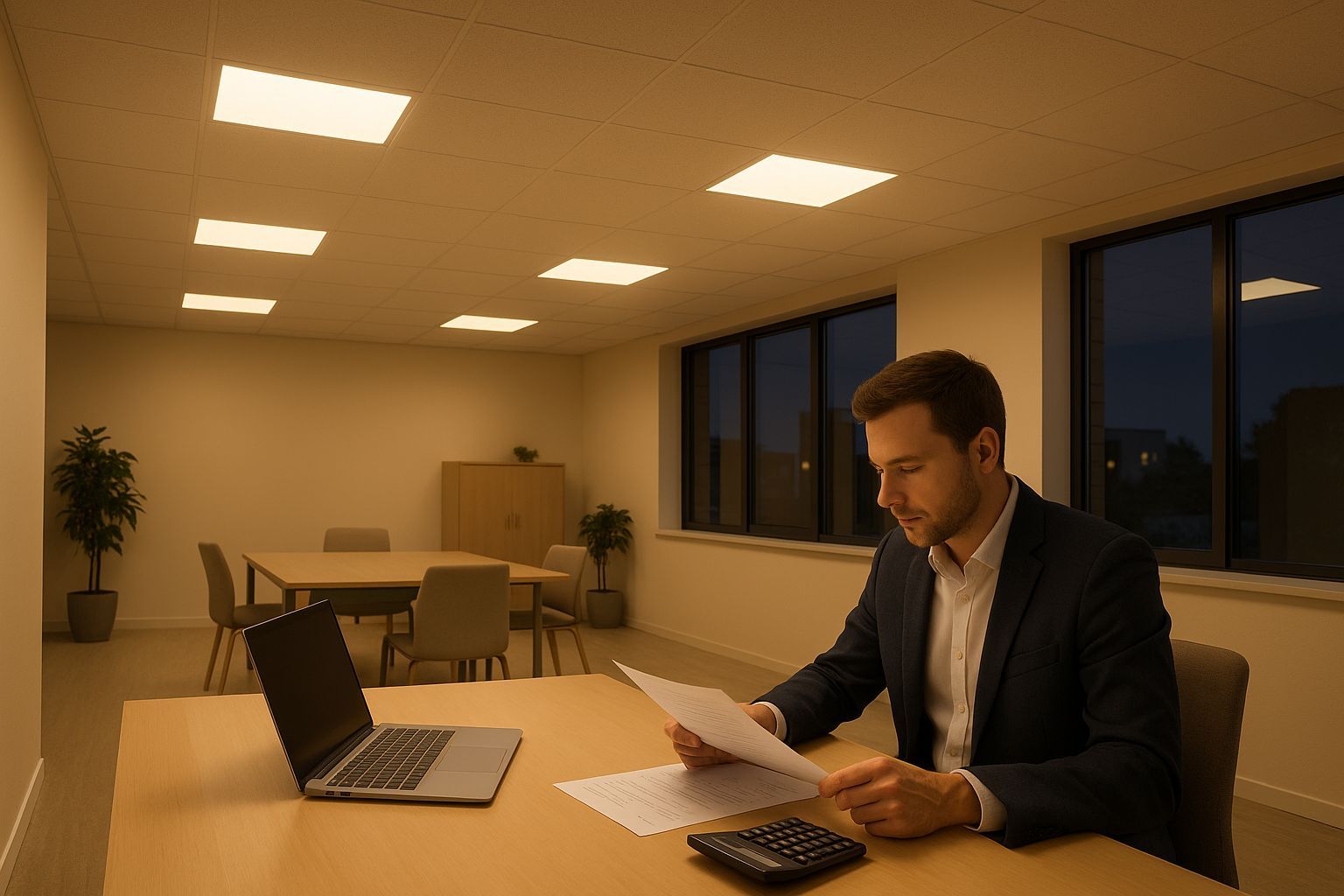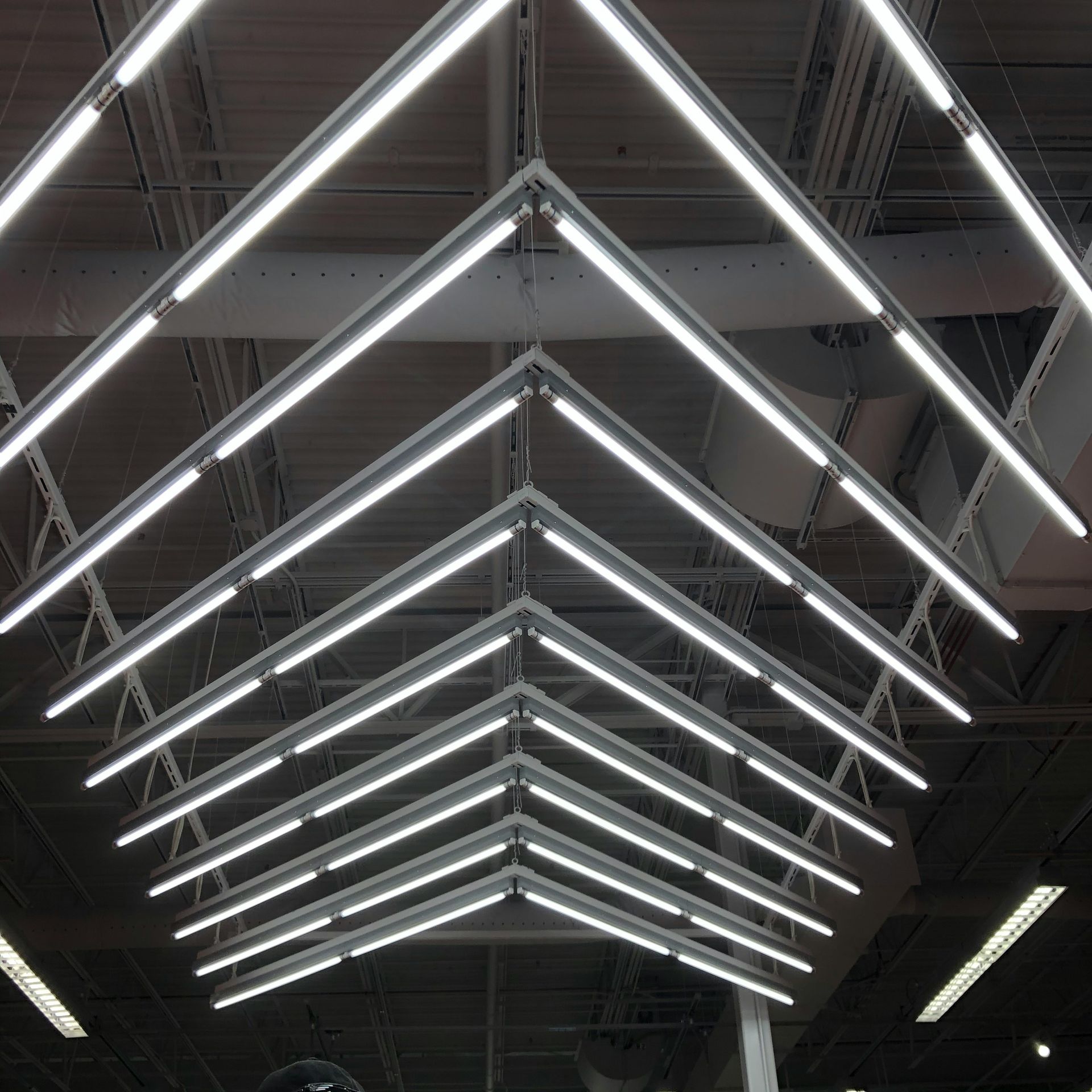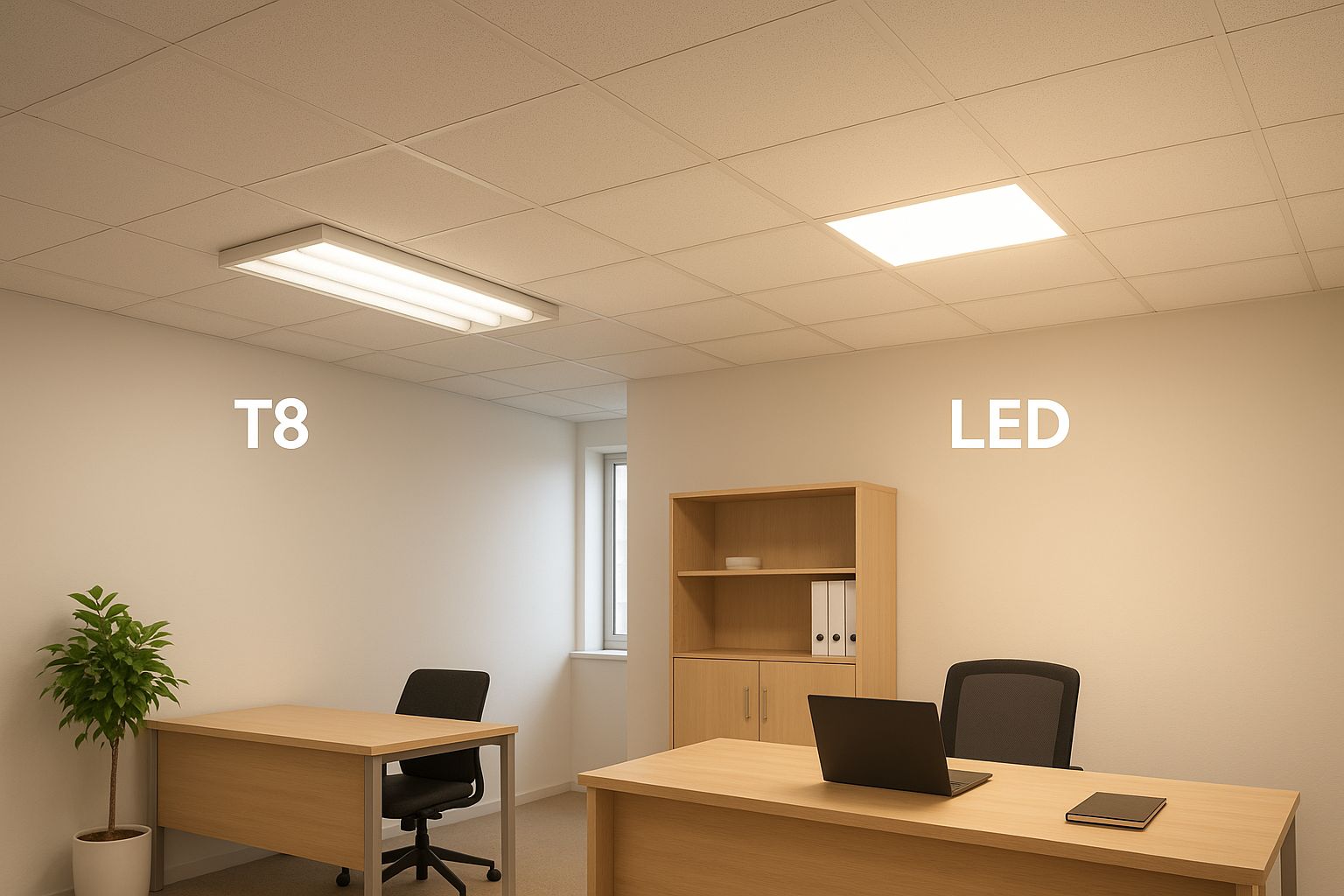Complete Guide to Commercial Lighting Codes
Complete Guide to Commercial Lighting Codes
Commercial lighting codes are rules that govern how lighting is designed, installed, and maintained in commercial spaces. They aim to ensure safety, reduce energy consumption, and meet accessibility standards. Here's a quick summary:
- Why They Matter: Proper compliance lowers energy costs, improves safety, and boosts property value.
- Key Codes: ASHRAE 90.1, IECC, and California's Title 24 set energy efficiency standards, while OSHA and ADA focus on safety and accessibility.
- 2025 Updates: Stricter power limits, expanded demand response, and advanced lighting controls are now required.
- Compliance Tips: Conduct energy audits, use LED retrofits, and integrate smart controls for efficiency and compliance.
Failing to meet these standards can result in fines, legal challenges, and lost savings. The article explores how to navigate these codes effectively and outlines strategies for compliance.
Electrical and Lighting Control Requirements for the IECC
Major Energy Codes and Standards
Grasping the key energy codes and standards is essential for ensuring compliance in commercial lighting across the United States. These regulations lay the groundwork for energy-efficient lighting design, helping businesses meet legal obligations while working toward sustainability objectives.
ASHRAE 90.1 and IECC
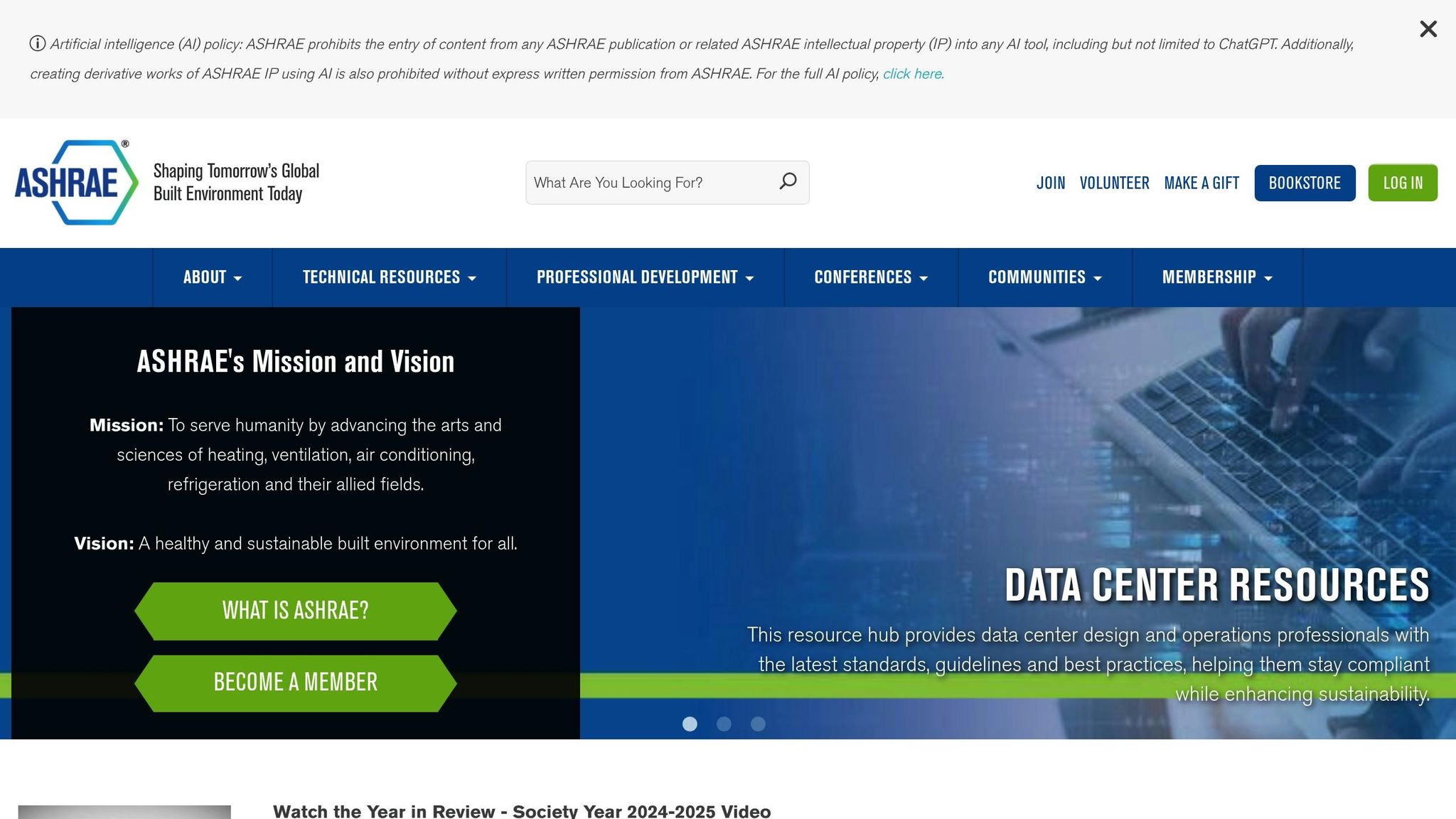
In the U.S., ASHRAE 90.1 and the International Energy Conservation Code (IECC) are the primary energy codes for commercial buildings. Both aim to enhance the energy efficiency of new construction and renovation projects, though they use different approaches to achieve compliance. States can adopt either ASHRAE 90.1, IECC, or even create their own custom codes. Interestingly, the IECC recognizes ASHRAE 90.1 as an alternative compliance path, creating some overlap between the two. It's anticipated that about half of the states will align with one of these standards, with many likely adopting the 2021 IECC.
Both codes regulate maximum lighting power allowances and require the use of lighting controls. Lighting expert Craig DiLouie explains:
"In terms of lighting, there are many similarities between 90.1-2019 and the 2021 IECC, which constantly seek alignment. At the core, these lighting sections prescribe maximum lighting power allowances and mandate various measures, predominantly lighting controls."
These codes are updated regularly to incorporate advancements in LED and lighting control technologies. However, there are notable differences between the two that can influence project planning and compliance efforts.
One key difference lies in climate zone classifications. The IECC uses data from the U.S. Department of Energy's Pacific Northwest National Laboratory , while ASHRAE 90.1 relies on research from ASHRAE Standard 169, which dates back to 2009. This can result in varying classifications for the same location.
Additionally, their scope and focus differ. ASHRAE 90.1 excludes low-rise residential buildings, making the IECC the go-to resource for such projects. ASHRAE, with members from over 132 countries, takes a global approach to efficiency standards, whereas the IECC is designed specifically for state-level adoption in the U.S..
Ultimately, selecting between ASHRAE 90.1 and IECC depends on the unique needs of a project. Energy efficiency experts Tim Milam and Ross Bush emphasize:
"The 'right' standard is the one that meets the objectives; the choice of which standard to use for a project should be based on the efficiency goals and the standard that will best achieve them, as neither is inherently better than the other."
These two codes set the groundwork for understanding state-specific regulations like California’s Title 24, which leads the way in energy efficiency.
Title 24 and New Trends
California’s Title 24 is among the most stringent energy codes in the U.S. and often predicts future national trends. Created by the California Energy Commission , Title 24 applies to all residential and nonresidential buildings in the state and is updated every three years. Its impact is far-reaching: Title 24 requirements are projected to generate $1.5 billion in consumer savings and cut 10 million metric tons of greenhouse gas emissions over the next 30 years.
Title 24 stands out for its clarity and specific mandates. Charles Knuffke, Systems VP at Wattstopper , highlights:
"The California code is written the best and is most readable. California was also the first to regulate mandatory dimming. Title 24's code regarding occupancy sensors is simple and specific. ASHRAE is more complicated, but the efforts behind these different code standards are to harmonize with one another."
Some of the key differences between Title 24 and national codes include lighting power density limits. For instance, IECC and ASHRAE set a limit of 0.61 watts per square foot (W/ft²), while Title 24 allows up to 0.65 W/ft². Another distinction lies in receptacle control: IECC and ASHRAE require it for both new construction and retrofits, but Title 24 mandates it only for new construction.
The upcoming 2025 updates to Title 24 aim to align more closely with ASHRAE and IECC. Changes include stricter daylight control requirements, with automatic daylight controls now required for spaces using 75 watts or more in a zone, down from the previous 120-watt threshold. This adjustment brings it in line with ASHRAE.
Across all codes, new trends point to stricter energy efficiency requirements. Lower lighting power allowances reflect the growing efficiency of LED technology, while advanced lighting control strategies continue to evolve.
While energy codes focus on efficiency, other regulations address workplace safety and accessibility.
OSHA and ADA Compliance
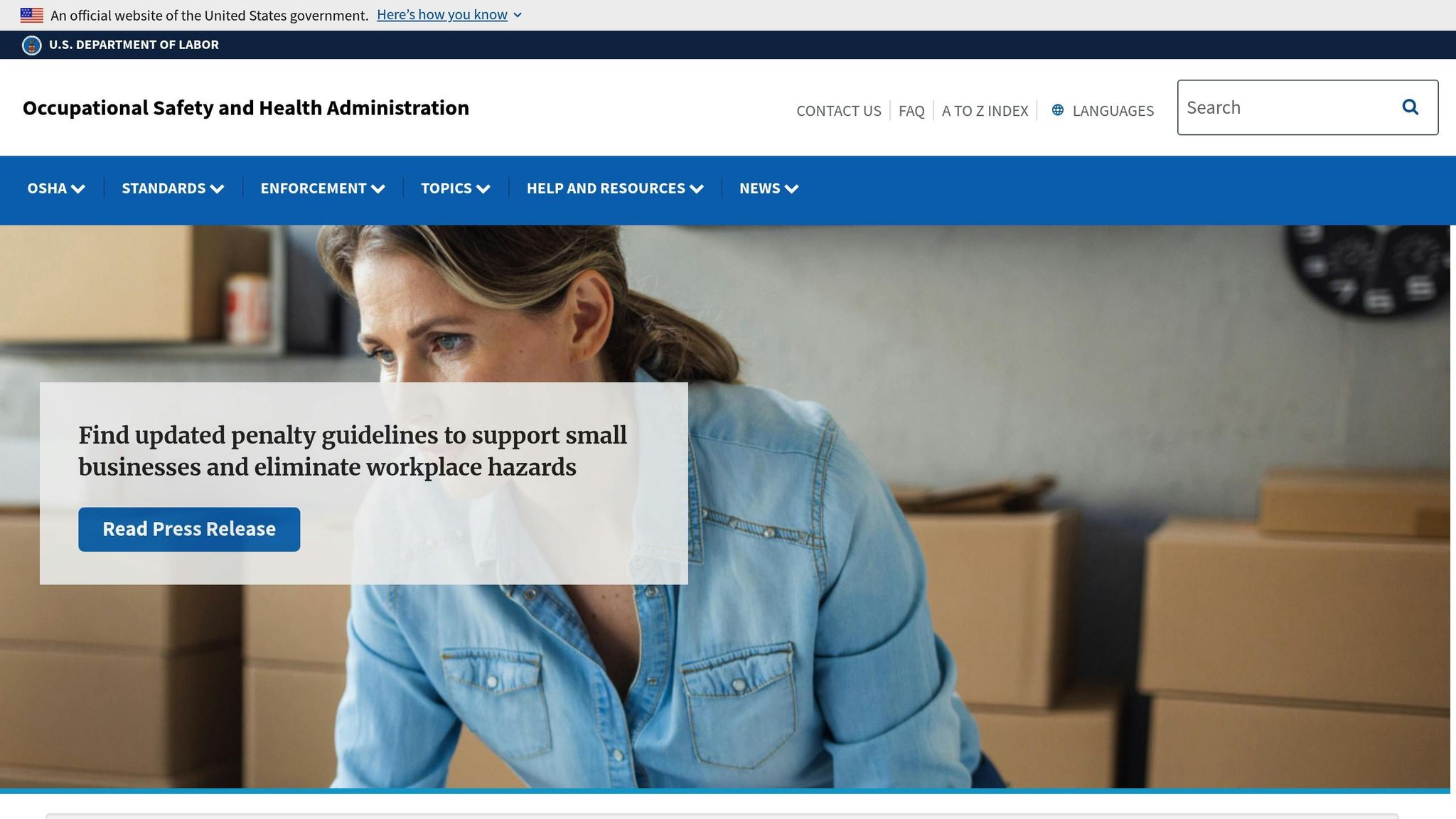
Beyond energy efficiency, compliance with OSHA and ADA standards ensures that lighting systems are safe and accessible. OSHA sets minimum illumination levels for various workplace areas, mandates clearly visible exit routes and signs, and requires emergency lighting systems with backup power sources like batteries or generators. This ensures that exit signs remain visible and routes are illuminated even during power outages.
ADA compliance focuses on maintaining accessibility for individuals with disabilities. This includes consistent lighting levels, reduced glare, and clear wayfinding systems in public spaces.
Regular maintenance - such as replacing bulbs and repairing fixtures promptly - is essential for meeting these standards. Conducting lighting audits can help businesses evaluate their current systems, energy use, and compliance with local codes. Upgrading to energy-efficient solutions like LEDs not only reduces energy consumption but also enhances safety with better illumination and smart control features.
Failing to comply with OSHA and ADA regulations can result in fines, legal issues, and damage to a company’s reputation. However, integrating these safety and accessibility requirements with energy code compliance creates commercial spaces that are efficient, safe, and welcoming for everyone.
2025 Updates and Compliance Requirements
The 2025 updates bring tighter power density limits, improved control systems, and expanded demand response requirements for both new construction and retrofits. These changes mark a shift toward more detailed standards for lighting controls and energy management.
New 2025 Lighting Code Changes
The standout changes in 2025 focus on lower power density limits and expanded control requirements. Lighting power density for certain spaces is reduced by about five percent, reflecting advancements in LED technology and its widespread use.
Daylight zone controls now have stricter requirements, particularly for spaces over 250 square feet. The threshold for daylight harvesting systems has dropped from 120 watts to 75 watts per zone. This means more commercial spaces will need to incorporate daylight-responsive systems to remain compliant.
Another major update involves demand response mandates. Charles Knuffke, Systems VP at Wattstopper, highlights this shift:
"Now, the code will require new buildings to include plug loads as to be part of their demand response. These requirements will be tailored to individual spaces now, and not just entire buildings."
This change emphasizes space-specific energy management, requiring new buildings to integrate plug loads into their demand response strategies. By focusing on individual spaces, energy consumption can be managed with greater precision.
The updates also introduce more flexibility for control placement. Manual switches in non-residential spaces can now be secured with lockable controls. Additionally, designers are allowed to position manual lighting controls in remote locations, provided they include a pilot light for visibility.
Smart lighting controls and building management systems are now a bigger focus in rebate programs. These programs encourage the integration of smart controls, especially in high-energy commercial spaces, to drive greater energy savings.
Compliance for New Construction and Retrofits
The 2025 updates outline distinct compliance strategies for new construction and retrofit projects. While new buildings incorporate these features from the start, retrofits must adapt existing systems to meet updated standards.
New construction projects are required to align with the updated power density limits, daylight controls, plug load demand response, and smart controls. This also includes thorough documentation during the design and commissioning phases. Coordinating between electrical, lighting, and building automation systems is critical for integrating smart controls into new projects .
Retrofit projects, on the other hand, face unique challenges. While not all new construction requirements apply, retrofits that trigger major system upgrades must meet the updated standards. This often involves LED conversions paired with occupancy sensors, daylight harvesting, and demand response capabilities.
LED retrofits remain a key strategy, offering the potential to reduce lighting energy use by 50-70% in many cases. However, the 2025 updates demand more than just replacing lamps. With stricter power density limits, some existing systems may no longer comply, prompting the need for comprehensive upgrades that combine LED technology with advanced controls to achieve compliance and energy savings.
To ensure compliance, projects must document all lighting system specifications and conduct regular energy audits. For retrofits, these audits can uncover opportunities to exceed basic compliance and achieve additional energy reductions .
Expert involvement is crucial under the 2025 updates. Partnering with qualified lighting designers ensures projects meet OSHA, ANSI/IES, and local code requirements. The integration of demand response, daylight controls, and smart building systems often requires specialized knowledge to navigate these complexities effectively.
Methods for Code-Compliant Lighting Design
Staying aligned with updated code requirements calls for thoughtful design strategies that balance energy efficiency with functionality. Achieving a lighting system that meets commercial energy codes requires a structured approach, as detailed below.
Energy Audits and Design Planning
A successful lighting design begins with a detailed audit. This process evaluates light levels, energy consumption, and compliance, laying the groundwork for improvements. The audit helps identify gaps and sets a clear path for achieving code-compliant lighting.
Understanding the specific needs of a space is critical. Different commercial environments demand tailored lighting solutions. For instance, the audit should document the current lighting power density and compare it against the latest code limits. For example, the 2021 IECC sets a maximum lighting power density of 0.64 watts per square foot for commercial office buildings - a notable reduction from the 1.3 watts per square foot allowed under the 2003 IECC.
Clear goals are essential for guiding the design process. These often include improving visibility, ensuring safety, supporting specific tasks, meeting code standards, and reducing energy use. The design phase should address various lighting types, such as ambient, task, accent, and emergency lighting. Collaboration between architects and engineers ensures that all elements work together seamlessly.
Advanced design software, like DIALux or AGi32 , can model layouts and optimize fixture placement. Experienced professionals can further refine designs by coordinating efforts and addressing potential challenges through a systematic approach.
LED Retrofits and Smart Controls
Modern compliance often hinges on LED retrofits and smart lighting controls. LEDs are a game-changer, offering significant energy savings. These upgrades are crucial for meeting stringent power density requirements.
Smart lighting systems provide the level of control needed to comply with codes like ASHRAE 90.1 and IECC. As energy codes evolve, they demand lower power allowances and more precise control systems. For instance, ASHRAE 90.1-2022 introduces updated lighting control requirements, including occupancy sensors in open offices and stricter thresholds for daylight-responsive systems. Similarly, IECC emphasizes sophisticated control strategies, pushing for controls at the level of small groups or even individual fixtures.
Occupancy sensors help conserve energy by automatically turning off lights in unoccupied spaces, while daylight-responsive controls adjust artificial lighting based on the availability of natural light. A study by the Northwest Energy Efficiency Alliance and DLC found that luminaire-level lighting controls can save an average of 63% in energy during regular business hours compared to systems without such controls. Additionally, the U.S. Department of Energy reported a 10.6% energy cost savings tied to the 2021 IECC revisions.
Documentation and Testing Requirements
Comprehensive documentation and rigorous testing are vital for proving compliance and maintaining system performance. Every lighting control system must be installed according to approved plans and manufacturers' guidelines, with functionality verified through thorough testing.
Documentation should include detailed records of system specifications, installation steps, and maintenance activities. These records must cover information like testing dates, technician details, observations, results, any repairs made, and the certifier's signature. Most jurisdictions require retaining these records for at least four years.
Emergency and exit lighting systems have specific testing protocols to ensure life safety compliance. Monthly tests confirm that emergency lighting activates within 10 seconds of a power outage and stays illuminated for at least 30 seconds. Annual tests involve a 90-minute operation on battery backup.
| Testing Requirement | Monthly Test | Annual Test |
|---|---|---|
| Frequency | Every 30 days | Once per year |
| Duration | Minimum 30 seconds | Minimum 90 minutes |
| Focus | Functionality check | Full system endurance test |
| Common Findings | Burned-out lamps, loose covers | Battery degradation, fixture wear |
All documentation related to the lighting and control system must be handed over to the property owner. Establishing a structured testing plan and working with reliable partners ensures system readiness while avoiding penalties. Regular testing also helps identify and address potential problems before they escalate into compliance violations or safety risks. These practices form the backbone of an efficient and code-compliant lighting strategy.
sbb-itb-86fe545
Luminate Lighting Group Solutions for Compliance
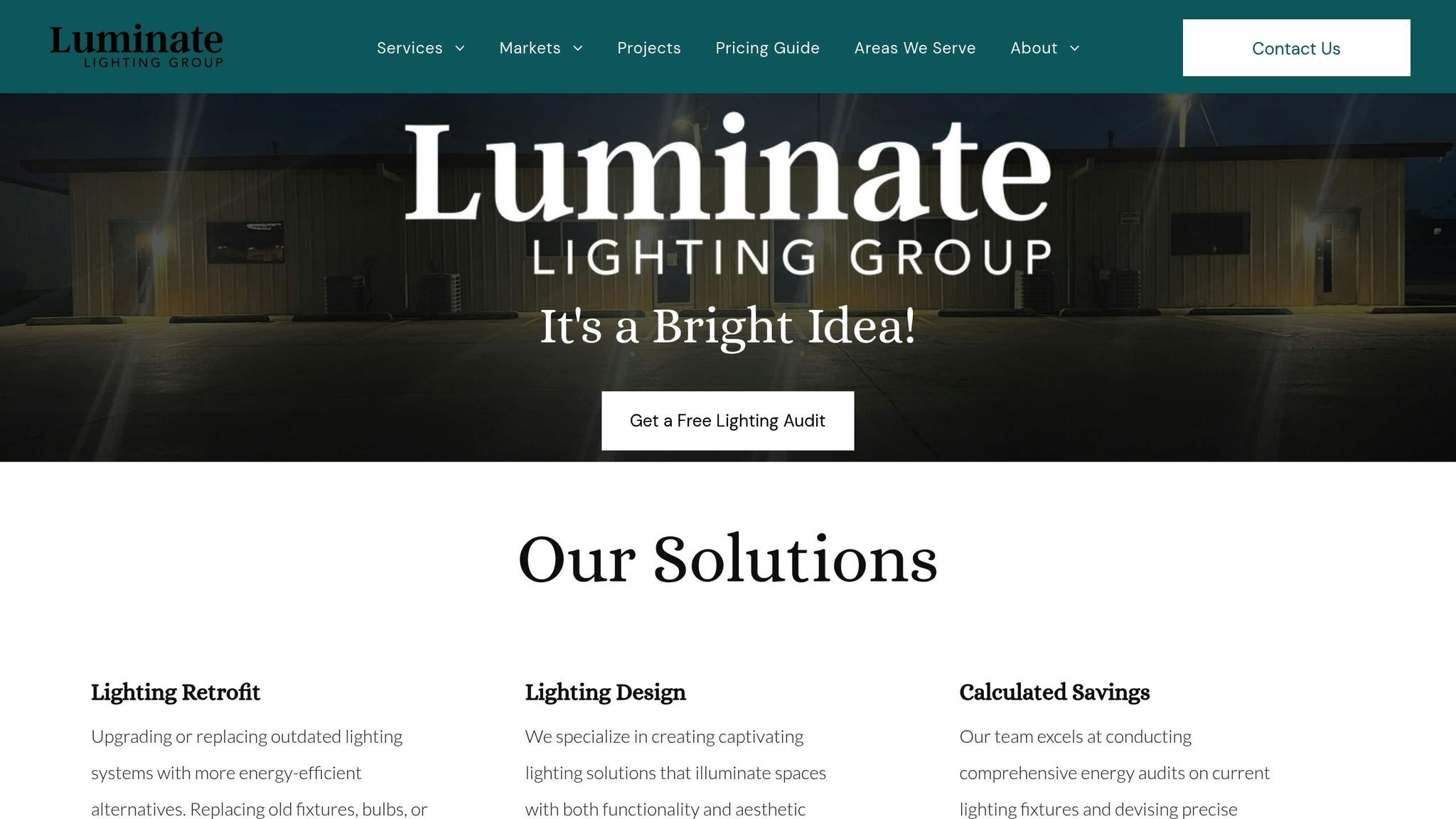
Luminate Lighting Group takes compliance to the next level by offering tailored lighting solutions for commercial projects. With over 40 years of industry expertise and 20 years specializing in commercial real estate, they combine deep knowledge with practical strategies to ensure code compliance while optimizing energy savings.
Comprehensive Services for Every Project
When it comes to designing and installing code-compliant lighting systems, Luminate Lighting Group provides a full range of services. They transform thorough assessments into custom lighting designs that align with Title 24, IECC, ASHRAE 90.1, and local energy codes, all while helping clients take advantage of potential rebates and tax incentives.
Their solutions include high-performance LED fixtures paired with advanced controls like dimming systems, occupancy sensors, and daylight harvesting technologies. These features address the sophisticated control requirements of today’s energy codes.
Luminate also offers cost-conscious fixture and control options, ensuring businesses can meet compliance standards without straining their budgets. From initial assessments to final commissioning and documentation, their services cover every step of the process, providing seamless project management.
Maximizing Rebates and Cutting Costs
Luminate Lighting Group excels at helping clients navigate rebate programs to achieve maximum savings while maintaining compliance. Their team understands the complexities of utility rebates, tax incentives, and energy efficiency programs, which can significantly reduce project expenses.
The results speak for themselves. For instance, a corporate office cut lighting costs by 40% using Luminate’s LED solutions, while a warehouse slashed energy expenses by 50% following a full retrofit.
"The Luminate team retrofitted the lighting in a few of our commercial properties, and I couldn't be more pleased with the quality of the work, the value they provided, and the level of service. I highly recommend their work." - C. Bennett, Building Owner
Their rebate assistance goes beyond basic application support. By designing systems that meet or exceed utility program criteria, Luminate often secures higher rebate amounts and speeds up approval processes.
Custom Lighting for Varied Industries
Different industries require different lighting strategies, and Luminate Lighting Group delivers solutions tailored to specific commercial needs. Whether it’s a warehouse, office, healthcare facility, or educational institution, they create custom lighting designs that ensure compliance and efficiency.
For warehouses, Luminate focuses on high-output LED fixtures with motion sensors, meeting industrial standards while cutting energy usage. A standout example comes from a Dallas, TX warehouse, where replacing 6-lamp T8 fluorescent fixtures with high-output LED UFO fixtures equipped with motion sensors led to impressive results.
Office spaces benefit from lighting designs that prioritize productivity and energy efficiency, addressing factors like task lighting, daylight integration, and occupancy patterns.
Healthcare and educational facilities rely on Luminate’s expertise in meeting specialized lighting codes and safety requirements. The company also uses its extensive knowledge to help these facilities maximize sector-specific rebates and incentives.
Conclusion: Main Points for Commercial Lighting Compliance
Key Codes and Compliance Strategies
Navigating commercial lighting compliance means understanding the essential energy standards designed to cut energy costs and improve efficiency. Two major players in this field are ASHRAE 90.1 and the IECC, both of which are updated every three years to keep pace with new technologies and stricter energy goals. These standards are complemented by OSHA requirements for workplace lighting safety and ADA standards to ensure accessibility.
Adhering to these codes has a measurable impact, with studies showing that switching to LED lighting, retrofitting fixtures, or using occupancy sensors can slash energy usage and costs by 40%–75%.
California's Title 24 stands out for its clear regulatory framework, especially regarding occupancy sensors and plug load controls. While ASHRAE offers more intricate provisions, efforts are ongoing to align these standards across various codes.
Achieving compliance typically involves steps like energy audits, retrofitting with LED systems, and integrating smart controls. Proper documentation and functional testing ensure systems meet both performance expectations and regulatory requirements. These structured approaches not only meet compliance but also lead to significant energy savings, making them a smart investment.
Simplifying Compliance with Luminate Lighting Group
Implementing these compliance strategies can be complex, but expert guidance makes the process much smoother. Luminate Lighting Group specializes in energy-efficient lighting solutions that meet regulatory standards while maximizing energy savings and rebate opportunities.
"We design with Title 24, IECC, ASHRAE 90.1, and local energy codes in mind - maximizing your potential to receive rebates or tax incentives."
- Luminate Lighting Group
Luminate’s process begins with detailed energy audits and system designs that not only meet but often exceed code requirements. They also handle all the necessary documentation and testing to ensure compliance. Their expertise in rebate programs can help businesses offset significant project costs, all while achieving long-term energy efficiency.
Whether you're managing a warehouse, office, healthcare facility, or school, working with lighting professionals ensures your investment delivers maximum results. With commercial buildings wasting up to 30% of their energy, a well-designed lighting system can make a dramatic difference in efficiency and operational costs.
With the right guidance, proven solutions, and ongoing support, achieving and maintaining compliance becomes a straightforward process that delivers both immediate and lasting benefits.
FAQs
What’s the difference between ASHRAE 90.1 and the IECC, and how do I know which one to use for my commercial project?
The IECC(International Energy Conservation Code) addresses energy efficiency on a building-wide scale, making it a go-to choice for meeting local and state building codes. On the other hand, ASHRAE 90.1 dives deeper into specifics, providing detailed guidance on systems, equipment, and controls. This makes it a preferred option for projects that aim to refine energy performance and achieve higher efficiency benchmarks.
When deciding which standard to follow, start by reviewing your local building codes - most jurisdictions lean on the IECC. However, if your project involves intricate energy-saving strategies or demands precise system details, ASHRAE 90.1 could be a better match. In some cases, combining both standards can help you hit compliance and performance targets.
What changes in the 2025 commercial lighting codes will affect existing buildings and retrofit projects?
2025 Updates to US Commercial Lighting Codes
The 2025 revisions to U.S. commercial lighting codes, including Title 24 and the IECC, are set to prioritize energy efficiency and environmentally conscious practices in both existing buildings and retrofit projects. Among the key updates are mandates for automatic lighting controls, occupancy sensors, and dimmable LED fixtures. These measures are designed to cut energy use while ensuring compliance with the latest standards.
For businesses, this means taking a closer look at their current lighting setups and planning necessary upgrades to align with the new regulations. Beyond meeting compliance requirements, these changes offer the added advantages of reduced energy costs and better overall lighting quality over time.
What are the advantages of using smart lighting controls in commercial buildings, and how do they help meet modern energy codes?
Smart lighting controls in commercial buildings bring together energy savings, lower costs, and improved functionality. With features like occupancy sensors, daylight harvesting, and automated dimming, these systems ensure lights are used only when and where needed. This not only cuts down on energy consumption but also enhances safety and creates a more comfortable atmosphere for those inside.
By streamlining energy use, these systems help businesses align with modern energy codes such as ASHRAE 90.1 and the IECC. They simplify compliance with adaptive lighting and energy management requirements, making it easier to meet regulations while reducing operational costs and supporting sustainable practices.


